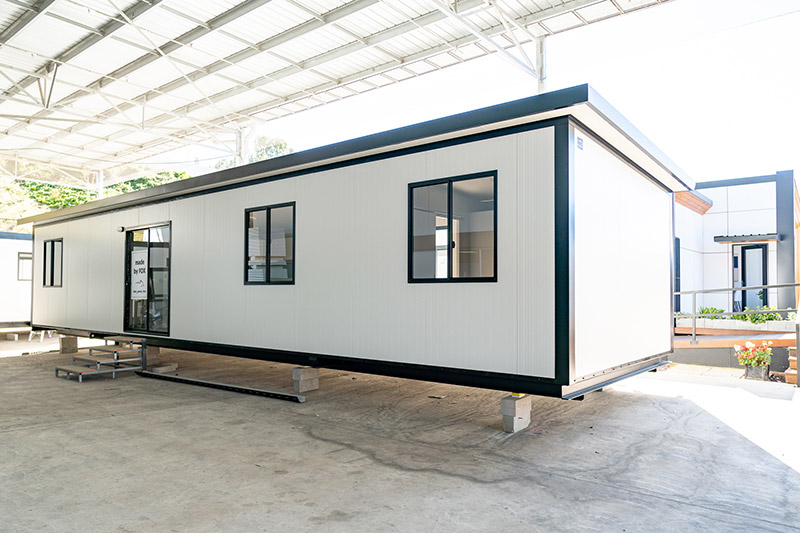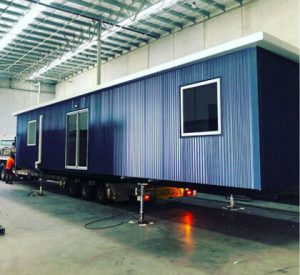The construction industry is under pressure to create structures that are sustainable, quick to build, top quality, and meet or exceed Australian Building Standards.
Prefabrication is a growing trend that meets these requirements and continues to gain traction across Australia.
What is Prefabrication?
The term prefabrication (also called prefab) refers to the type of construction where a building’s components are constructed off-site. Then, it is delivered and assembled to form a building or home.
There are two main types of prefabrication.
- Two-D Prefabrication involves the use of pre-cut, pre-sized, pre-moulded or pre-shaped elements that are assembled or installed on-site. Panels are ready to assemble upon arrival, making them an efficient option. The composition of the panels may differ, but the possibilities for assembly are almost limitless. Additionally, customisation for prefabricated Two-D panels is straightforward and meets the needs of the most discerning client.
- Three-D Prefabrication uses units (often called modules) that are assembled on the building site. These can be a single large building or combined with other components on-site. The modules are nearly completely assembled when they reach the designated destination.
How Does Prefabrication Work?
Prefabrication is a construction process which generally follows these steps.
- Preparation of Materials– Raw materials are compiled according to the specifics of the prefab design. Components will go to a manufacturing facility and readied for the prefabrication process.
- Off-site Prefabrication– The modules or panels are built according to the designer’s specifications at a production centre rather than at the construction site. Because many identical pieces are needed, this part of the process is easily completed in a timely manner. Sections of flooring, wall panels, doors, and roof trusses are examples of prefab pieces that are always necessary.
- On-site Assembly– The modules or panels are delivered to the building site for final assembly. On average, a prefabricated building can be ready in at least half the time needed for a traditional build.
Why Prefabrication is Consistently Gaining Popularity?
Efficiency
Prefabrication creates much shorter build times. Elements made in an off-site location benefit from the climate-controlled surroundings. Inclement weather or poor site conditions will not deter construction. Additionally, projects will move faster because building on-site and manufacturing prefabricated pieces can happen at the same time.
Cost Savings
Accuracy of budget projections, lower risk of cost overruns, and efficient methods of production all contribute to lower costs without sacrificing quality.
Quality Control
Because all parts involved in building prefab structures are monitored and constantly checked to ensure they are without defects, prefabricated items can reach significant levels of quality.
Components built in a factory setting undergo rigorous quality checks, resulting in high-quality outputs that improve the longevity of buildings.
Decreased Waste and Eco-Friendly Practices
The organised approach to production of prefabricated materials helps to limit waste because only necessary components are used. Reduced activity on the job site, as well as limited need to deliver materials, help make a smaller ecological footprint.
Safer Work Conditions
Because prefab components come from controlled environments, the chance of on-site accidents is reduced. Also, the chances of impact from faulty building materials and exposure to poor weather conditions are much less when using prefab instead of traditional methods.
How are Modular and Prefabrication Different?
While there are many similarities between modular and prefabrication, there are several differences as well.
- The types of prebuilt panels used
- Modular structures need less actual construction after delivery to the site.
- Differing components for each type
Five Benefits of Prefabricated Structures
Prefabricated buildings have a number of advantages to those who use them. Here are the top five reasons prefabrications are an excellent choice for numerous uses.
1. Flexibility
Prefabricated buildings offer a great deal of choice when it comes to configurations and uses. Additionally, because they are transportable, they can be redesigned, moved, or taken apart.
2. Safety
Because prefabs require less hands-on effort than traditional builds, construction crews will spend less time building a prefabricated structure. Additionally, crews will spend less time working in poor weather conditions.
3. Cost-Effectiveness
There are a number of ways to save by choosing prefabs. Bulk buying of materials, fewer workers, faster builds, and a reduced chance of human error are just a few examples of how to save money.
4. Eco-friendly
Most traditional construction sites contribute significant amounts of greenhouse gas emissions from the heavy equipment used over a long period of time. These sites also contribute to landfill waste. Prefabricated building helps eliminate these and other problems associated with the construction industry.
5. Quality Control
Prefabricated buildings are designed to meet exacting standards. This means the margin for error is significantly less than when measuring and building.
Applications of Prefabrication
Because of their versatility, prefabricated structures have a number of applications.
- Remote housing and facilities for FIFO workers
- Office space
- Healthcare facilities
- Additional space on school property for students and faculty
- Free-standing or connected retail space
- Laundry, dining, and kitchen facilities for mining camps
- Permanent buildings
- Caravan parks
- Additional space at your home
- Temporary, transportable buildings


